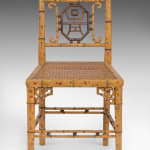Set of Four Regency Faux Bamboo Side Chairs attributed to Tatham Bailey and Saunders
33 x 17 ¼ x 17 ½ in
Further images
-
(View a larger image of thumbnail 1
)

-
(View a larger image of thumbnail 2
)

-
(View a larger image of thumbnail 3
)

-
(View a larger image of thumbnail 4
)

-
(View a larger image of thumbnail 5
)

-
(View a larger image of thumbnail 6
)

-
(View a larger image of thumbnail 7
)

-
(View a larger image of thumbnail 8
)

-
(View a larger image of thumbnail 9
)

Provenance
Commissioned by Mary, Marchioness of Downshire and 1st Baroness Sandys of Ombersley (1764-1836) for Ombersley Court, Worcestershire, and by descent.Literature
A. Oswald, 'Ombersley Court, Worcestershire - III', Country Life, 16 January 1953, p. 153, pl. 3.Ombersley Court Inventory, June 1963, annotated Ombersley MS, in 'The Chinese Chippendale Room'.
West London Press, 9 March 1962 picks out the urn table as a highlight of the exhibition.
These four chairs were originally part of a suite for the Chinese Room at Ombersley Court, Worcestershire, comprising an overmantel mirror, pier table and mirror, chaise longue, eight chairs, a foot stool (the chaise longue, two chairs and footstool now at Temple Newsam) and a fire screen (now in The Victoria and Albert Museum). The overall scheme for the Chinese Room included blue walls hung with 'Chinese' panels with simulated bamboo frames and window dressings framed with 'bamboo' arches.
Ombersley Court was originally completed in 1732 with work commissioned by Sir Samuel Sandys. Mary, Marchioness of Downshire and 1st Baroness Sandys of Ombersley (1764-1836), known as ‘The Little Marchioness’, was widowed in 1801 with seven children. She made large scale alterations to Ombersley Court carried out by John Webb (c. 1754 –1828) of Lichfield including refacing the building in 1812-14 and altering a seven bay entrance side of two and a half storeys with a new portico of Ionic columns.
The alterations prompted commissions for new furniture. The Prince Regent stayed at Ombersley for several days in 1807 and may have contributed to the Marchioness’s desire for chinoiserie. The furniture for the Chinese Room at Ombersley was similar to that provided by Elward & Marsh for The Royal Pavilion, Brighton from 1802, commissioned by the Prince Regent, for which they took their inspiration from imported Chinese lacquer and bamboo wares, reconfigured into Western forms.
The firm had other prestigious commissions to their name for bamboo and faux bamboo furniture:1801–02 Elward, Marsh & Tatham: Bills for work at Carlton House and Brighton including 36 carved bamboo japanned chairs £100.16.0’ for the 1801 Eating Room, Brighton Pavilion and an imitation bamboo cabinet (illus. Walkling (1979), p. 27). 1807 Tatham & Bailey: Payment £13 2s 6d for bath chair. c. 1808 Tatham & Bailey: Provided ‘6 bamboo chairs, japanned as Botany Bay wood’ for The Thornery, Woburn.
The vogue developed in England following the publication of William Chambers’ ‘Designs of Chinese Buildings, Furniture, Dresses, Machines, and Utensils’ in 1757. Chambers travelled to China three times in the 1740s with the Swedish East India Company and produced the volume, the first in Europe to methodically study Chinese architecture, gardens, clothes, machines, furniture and domestic objects.
Simulated bamboo: Adam Bowett writes in Woods in British Furniture-Making 1400-1900 An Illustrated Historical Dictionary (Oblong, 2012) 'Probably as a result of Chambers' book, 'bamboo' furniture began to appear in British houses, and was apparently regarded as especially suitable for bedrooms. The inventory of David Garrick's house on the Adelphi terrace taken in 1779 records 'Six rush bottom Bamboo Chairs japanned green and white'...The Garrick chairs are painted wood; similarly the numerous references to 'bamboo' furniture in other late-18th century inventories are likely to imply simulated bamboo.' (p. 20)
In pattern books of the early Regency period various forms of carving, gilding and painting furniture were put forward with 'such deceptions as turned and painted beech in imitation of bamboo being particularly recommended.' (Frances Collard, Regency Furniture, Antique Collectors' Club, 1985, p. 80.) Sheraton described the technique of imitating bamboo by turning beech into the same form and painting it to match the colour of the canes is described in his 'Cabinet Dictionary (p. 29). He described bamboo as '...a kind of Indian reed, which in the east is used for chairs. These are, to some degree, imitated in England, by turning beech in the same form, and making chairs of this fashion, painting them to match the colour of the reeds or cane.'
In discussing the Chinese inspired furnishings at the Royal Pavilion, Brighton. Collard comments 'Simple materials like beech simulating bamboo and lacquer were favoured rather than the ebony and ormolu that had been used at Carlton House, emphasising the gay informality of the new taste rather than the stylish and rich pieces made earlier.' (ibid. p. 196).
Tatham, Bailey and Saunders: Founded in the 1780s, the firm had premises at 14 Mount Street in Mayfair. The partnership originally comprised George Elward and William Marsh, with Edward Bailey joining them in 1793 and Thomas Tatham (brother of the designer C.H. Tatham) in 1798. They were joined by Richard Saunders in 1811.









